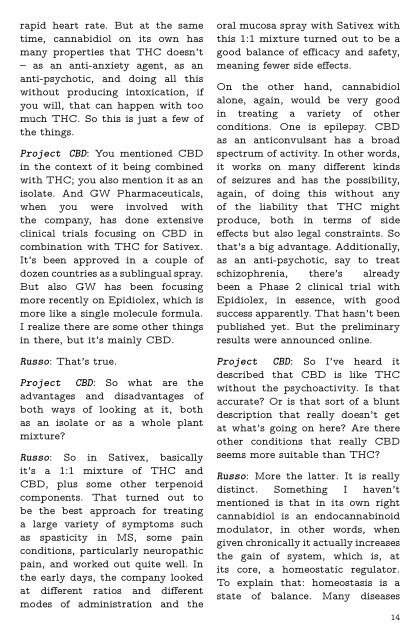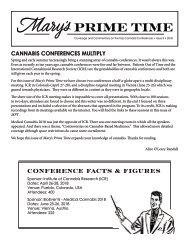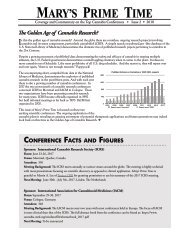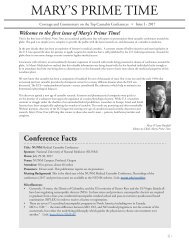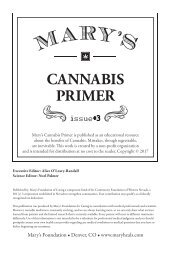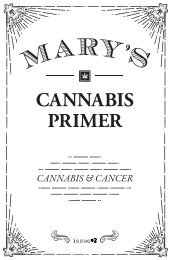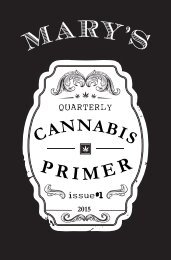#5: It's a Hemp Thing
Mary's Cannabis Primer is published as a resource for national and international education about the benefits of Cannabis. This issue is dedicated to Hemp.
Mary's Cannabis Primer is published as a resource for national and international education about the benefits of Cannabis. This issue is dedicated to Hemp.
You also want an ePaper? Increase the reach of your titles
YUMPU automatically turns print PDFs into web optimized ePapers that Google loves.
apid heart rate. But at the same<br />
time, cannabidiol on its own has<br />
many properties that THC doesn’t<br />
– as an anti-anxiety agent, as an<br />
anti-psychotic, and doing all this<br />
without producing intoxication, if<br />
you will, that can happen with too<br />
much THC. So this is just a few of<br />
the things.<br />
Project CBD: You mentioned CBD<br />
in the context of it being combined<br />
with THC; you also mention it as an<br />
isolate. And GW Pharmaceuticals,<br />
when you were involved with<br />
the company, has done extensive<br />
clinical trials focusing on CBD in<br />
combination with THC for Sativex.<br />
It’s been approved in a couple of<br />
dozen countries as a sublingual spray.<br />
But also GW has been focusing<br />
more recently on Epidiolex, which is<br />
more like a single molecule formula.<br />
I realize there are some other things<br />
in there, but it’s mainly CBD.<br />
Russo: That’s true.<br />
Project CBD: So what are the<br />
advantages and disadvantages of<br />
both ways of looking at it, both<br />
as an isolate or as a whole plant<br />
mixture?<br />
Russo: So in Sativex, basically<br />
it’s a 1:1 mixture of THC and<br />
CBD, plus some other terpenoid<br />
components. That turned out to<br />
be the best approach for treating<br />
a large variety of symptoms such<br />
as spasticity in MS, some pain<br />
conditions, particularly neuropathic<br />
pain, and worked out quite well. In<br />
the early days, the company looked<br />
at different ratios and different<br />
modes of administration and the<br />
oral mucosa spray with Sativex with<br />
this 1:1 mixture turned out to be a<br />
good balance of efficacy and safety,<br />
meaning fewer side effects.<br />
On the other hand, cannabidiol<br />
alone, again, would be very good<br />
in treating a variety of other<br />
conditions. One is epilepsy. CBD<br />
as an anticonvulsant has a broad<br />
spectrum of activity. In other words,<br />
it works on many different kinds<br />
of seizures and has the possibility,<br />
again, of doing this without any<br />
of the liability that THC might<br />
produce, both in terms of side<br />
effects but also legal constraints. So<br />
that’s a big advantage. Additionally,<br />
as an anti-psychotic, say to treat<br />
schizophrenia, there’s already<br />
been a Phase 2 clinical trial with<br />
Epidiolex, in essence, with good<br />
success apparently. That hasn’t been<br />
published yet. But the preliminary<br />
results were announced online.<br />
Project CBD: So I’ve heard it<br />
described that CBD is like THC<br />
without the psychoactivity. Is that<br />
accurate? Or is that sort of a blunt<br />
description that really doesn’t get<br />
at what’s going on here? Are there<br />
other conditions that really CBD<br />
seems more suitable than THC?<br />
Russo: More the latter. It is really<br />
distinct. Something I haven’t<br />
mentioned is that in its own right<br />
cannabidiol is an endocannabinoid<br />
modulator, in other words, when<br />
given chronically it actually increases<br />
the gain of system, which is, at<br />
its core, a homeostatic regulator.<br />
To explain that: homeostasis is a<br />
state of balance. Many diseases<br />
14


